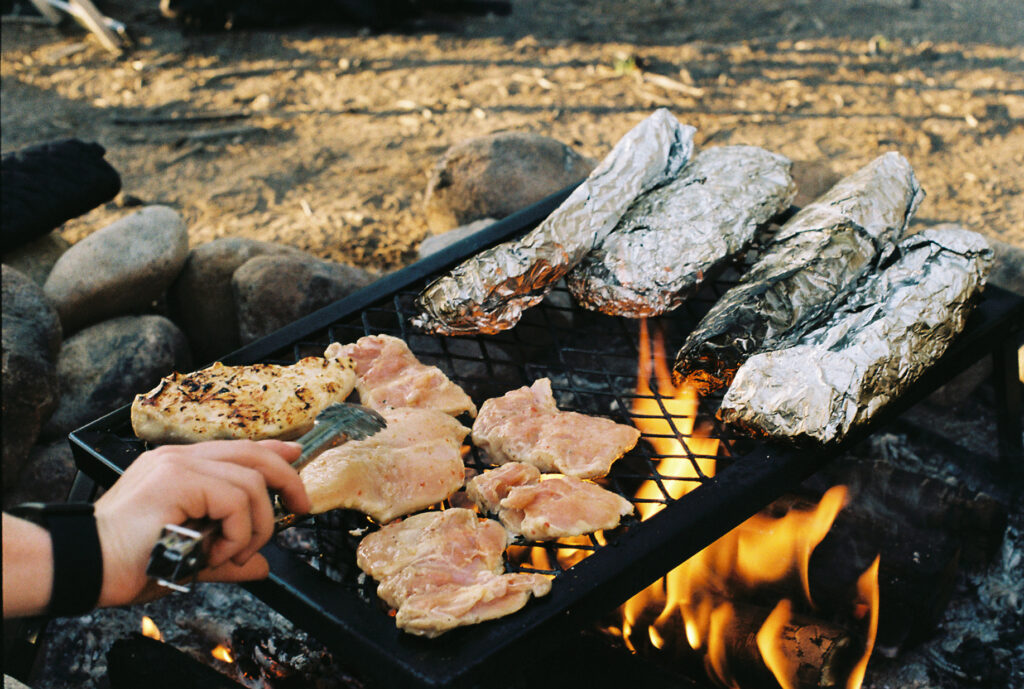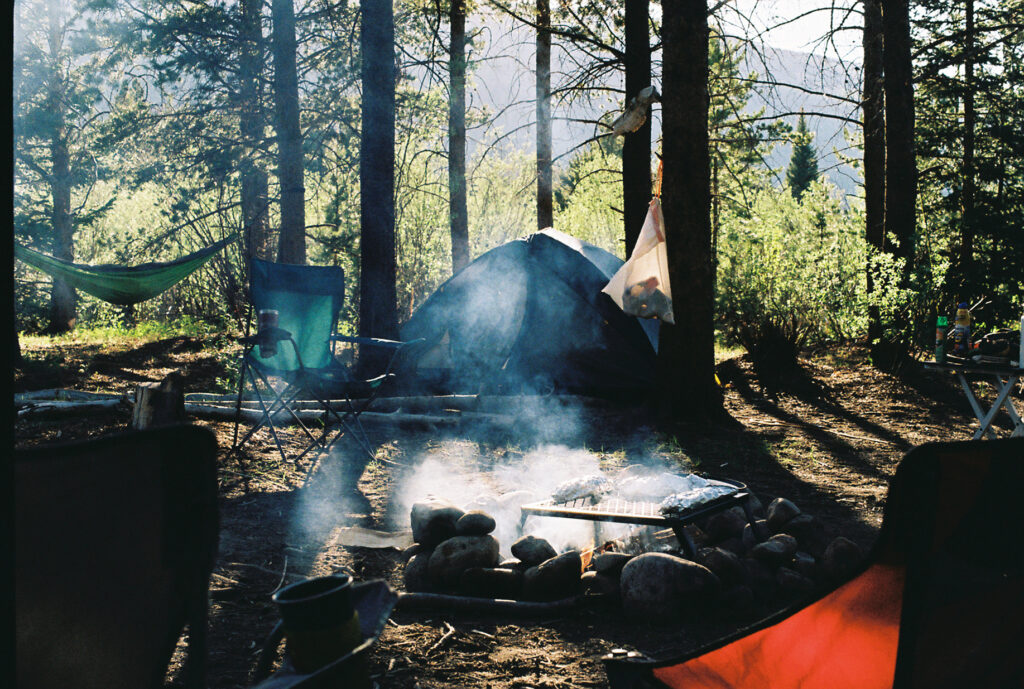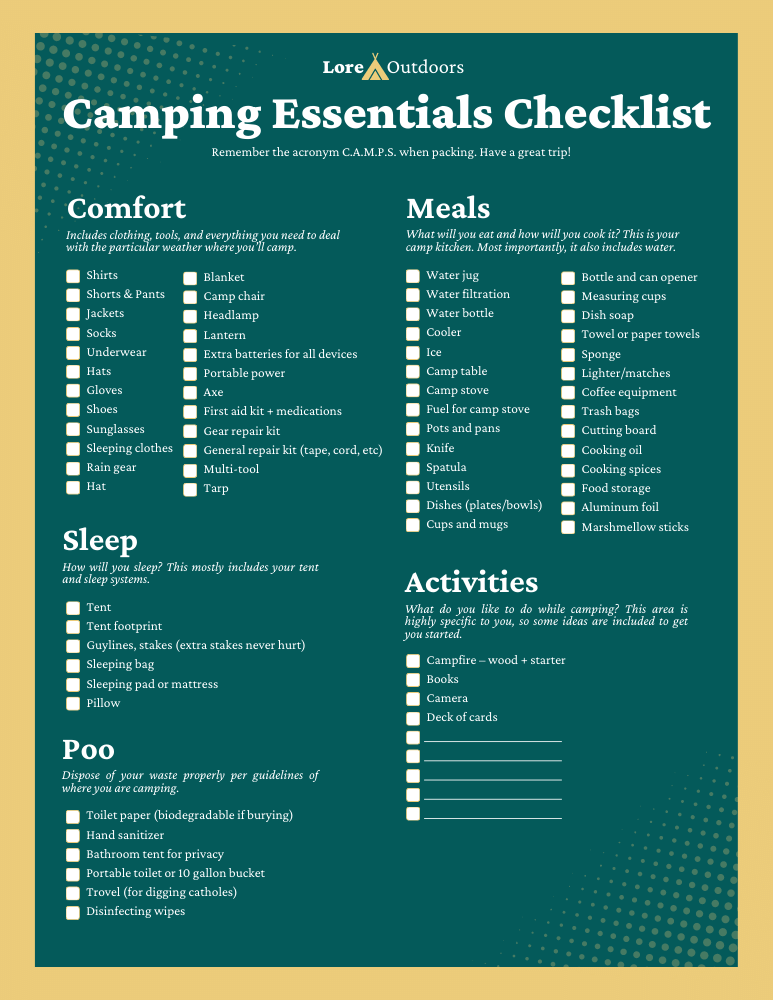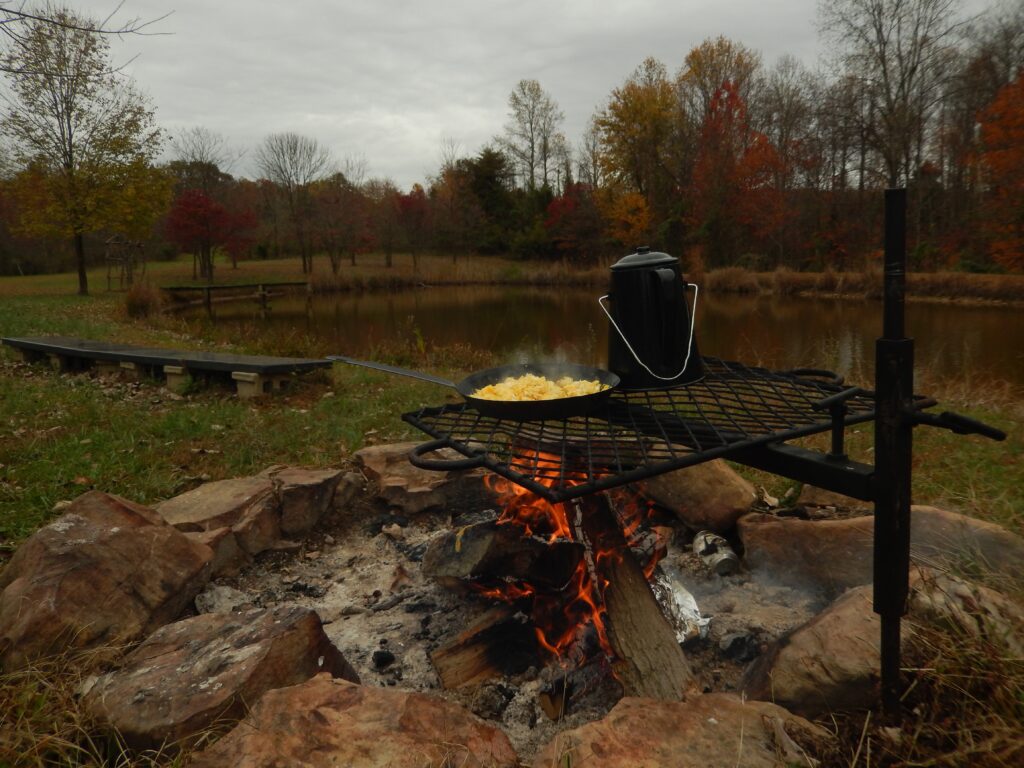Cooking around the campfire is one of my most beloved childhood memories. My family would make hobo meals, tossing potatoes, veggies, and ground beef into double-layered aluminum foil. Some oil, and a truck load of Lawry’s seasoned salt to finish the job, then we’d toss it directly on the fire to cook. As I’ve grown older my cooking skills have increased, and my equipment has upgraded alongside. While I still love a good foil meal, there are some better ways to cook delicious meals over an open fire. There are different campfire cooking kits and ways to cook over an open flame, and I’ll walk you through some of my favorites. Here’s everything we’ll cover in this post.
- The best campfire cooking kits (for each type)
- How to choose the right campfire cooking kit for you
- Accessories needed for campfire cooking
- Tips for cooking over an open flame
For the purposes of this article we’ll focus on the core cooking equipment, meaning what the food will actually cook on or in. From simple cast iron pans to chef-ready setups, there’s something here no matter your skill level. All right, here are my top picks for campfire cookin’.
The best campfire cooking kits
- Campfire Cooking Set – Stanley Adventure Camp Cook Set (comes with accessories)
- Campfire grill – Adventure Seeka Heavy Duty 24″ Folding Campfire Grill (swivel option available)
- Cast Iron pan or dutch oven – Lodge 12” Cast Iron Pan, Lodge 7 Quart dutch oven
- Tripod – Coleman Tripod Grill w/ Lantern Hanger
- Camping Griddle – Lodge Reversible Griddle
FYI: We’re a small team of outdoor experts and researchers that care about recommending quality, reliable outdoor products. If you choose to click a link and buy any of the products we recommend, we earn a commission at no additional cost to you.

Best campfire cooking set: Stanley Adventure Camp Cook Set
Stanley is a trusted brand in and out of the outdoor industry. You’ve likely seen their thermos everywhere from foundries to kid’s soccer tournaments. They know how to make quality products – especially from stainless steel, and their cooking set is no different.
The set focuses on a ~4 qt pot and 32oz frying pan made from, you guessed it, stainless steel. That would be enough, however Stanley includes all the accessories you need to round out your basic camp kitchen including utensils, plates, a cutting board, and a drying rack. It’s truly an all in one kit for your main cooking set needs, and they fit together in a nested package for easy portability or storage.
If you’re beyond the beginner stage and want to up the quality, Stanley offers their Even Heat camp cooking set which offers less accessories but higher quality core products.

Campfire grill: Adventure Seeka Heavy Duty 24″ Folding Campfire Grill
The simplest way to get started with campfire cooking is a campfire grill. These can also be known as grates. What I like about the Adventure Seeka is the fact that it comes with two different cooking sides—grill and griddle—for more flexibility in your cooking. Want to fry up some eggs and bacon over the fire? Slap them on the griddle side. Grilling up a steak or chicken? Then the grill side works no problem, and you can throw veggies on the griddle at the same time if you wish. The grill is easy to clean, foldable, and has plenty of cooking surface so you can feed the whole family. Simple, no frills, you can’t go wrong.
If your fire pit isn’t shaped well for the grill to sit over the top of it, then Adventure Seeka offers a great Swivel Campfire Grill option as well. This gives you the flexibility to set up the grill over the top of your campfire however you want, no matter what type of fire ring you have available. If you dispersed camp a lot or enjoy the flexibility then the swivel is a great option.

Cast Iron pan or dutch oven – Lodge 12” Cast Iron Pan, Lodge 7 Quart dutch oven
The cast iron pan is my favorite cooking tool, period. I use my Lodge cast iron pan at home and bring it with me on every camping trip. In my experience the flavor, durability, safety, and affordability of cast iron is impossible to beat. It’s not the best for foods like eggs that work best with non-stick. But meats, veggies, and potatoes sing on the cast iron. It’s heavy, but simple, and will last you a lifetime if taken care of properly. Side note: If cooking on cool nights I recommend grabbing a lid for your cast iron to help hold in heat. The pan by itself is better at heat retention than regular pans, but a lid goes a long way if cooking in cool temps.
If I had to buy one pan for cooking it would be a cast iron pan. That’s how much I rate this piece of equipment. Lodge is an easy winner at an affordable price in this arena. Just thinking about it makes me want to fire mine up for dinner.

Tripod: Coleman Tripod Grill w/ Lantern Hanger
Tripods are a different way to get a similar experience to the campfire grill. The main benefit is greater control over how high above the flame your cooking area is. You’ll often see folks grilling or hanging dutch ovens from tripods over a fire, in this case my recommendation, from camping stalwarts Coleman, showcases a grill. When looking for a tripod just make sure its secure and can handle the weight of your cooking surface and food below it. No need to get too spendy on the tripod itself here. Keep it simple and enjoy the aesthetics of a classic over-the-fire experience.

Camping Griddle: Lodge Reversible Griddle
I’m including a griddle here because of its value as a cooking surface and versatility. You can set a griddle over your campfire grill above the fire, or you can put it over any propane camping stove as well. I use griddles over propane stoves moreso than over fires, which is why its last on this list, but its usability at home or out camping while providing that delicious cast iron flavor makes it worth mentioning. My recommended griddle is affordable, reversible, and built by my favorite cast iron specialists Lodge. If you need a larger flat surface consider picking up a camping griddle.

How to choose the right campfire cooking kit
There are many ways to cook over an open flame. Deciding which way is right for you is just down to preferences. Here are the factors you should consider when choosing what kit is best for you:
- What type of food do you want to cook? This will effect what materials are best for your cooking equipment. Are you focused on grilling foods like meats and big cuts of veggies? Then cast iron or campfire grills are your best bet. Are you cooking the same as you do at home? Then stainless steel may be right for you since you’ll want a surface similar to non-stick.
- How many people are you cooking for? A small pan like in my recommended Stanley kit works great for two people, but if you’re feeding a battalion of kids who have been outdoors all day you’ll want a larger camping surface. This is where tripods and grills come in handy. You may also need to add in extra components to your kit to cook everything you need. For example, a big enough campfire grill lets you grill meats directly on it while other foods cook in a pot next to it.
- What type of camping are you doing? Portability is the name of the game here. If you’re limited on space and camping in a campground they may have grills attached to the campsite fire ring and you may not more than a cast iron pan and accessories. But if you’re out in the mountains with a natural built fire pit you’ll need your full setup from scratch. Research where you’re camping beforehand to help you figure out what you need to bring.
- How advanced of a cook are you? Are you searing perfect steaks over the open flame or are you throwing canned beans in a pot to heat up? Both work and both are delicious, but both require different tools. Luckily, I do think this is more about adding accessories and food choices more so than your basic gear. You can do basic or advanced cooking on a cast iron pan or in a dutch oven and it’ll never go out of style, but it may change your starting point.
Materials: Cast iron, stainless steel, or aluminum?
I recommend cast iron or stainless steel for camp cooking over aluminum. They both win on durability, safety, and deliciousness. Aluminum options can be cheaper and lighter, but they can also introduce non-stick coatings that wear over time and can become dangerous if cooked over high heat. Since campfires are harder to control I don’t recommend aluminum because it can’t handle high heat as well as steel or cast iron. With proper care both cast iron and stainless steel will last decades, stay trustworthy and safe, and in my opinion offer a better meal.
The downfall of both is they require a bit of learning to cook well on them. I think it’s worth it but beginners may enjoy the ease of nonstick surfaces, forgiving qualities, and ease of cleaning with aluminum options. Stainless steel can suffer from hotspots on the pan and you may struggle with sticking if you don’t properly preheat the pan. Cast iron, if overheated, can struggle to cool down to proper cooking temperatures. But these intricacies are easily learned with practice and knowing them will serve you well both camping and at home.
Cleaning is a factor some consider when choosing materials, but I’d recommend not making a decision based on this. Yes, cast iron is harder to clean and maintain, but it’s worth it and I stand by that recommendation. Aluminum is the easiest to clean and handle, but not so much that its worth what you give up in flavor, durability, and safety.


Use our printer-friendly checklist as a shopping list or packing list for your next camping trip.
Accessories for campfire cooking
If you show up to your campsite with a cast iron pan and nothing else, you may be in for a rough meal. Just like cooking at home the right accessories will make your campfire cooking kit complete. Below is a quick list of basic accessories to remember and also a few of my personal favorites I use often because they’re fun, bring good camp vibes, or are just dang useful.
- Camping storage box – I put all my cooking gear in a storage box that comes with me. It helps keep you organized and everything easy to access. I go in detail on camping storage here, but my easy favorite and the box I use every day is the Rubbermaid Actionpacker.
- Utensils – Forks, knives (both for eating and chopping), spoons, spatulas (the right material for each cooking surface), ladles, plates, bowls, cups. The basics. Don’t forget a cutting board either. Here’s a great simple silicone kit, a steel kit with literally everything you need, a plate that’ll last you decades
- Cleaning supplies – A small cleaning kit is super useful for cleaning up after yourself. Small dish soap, a camping sink, a sponge or other cleaning aid for scrubbing and wiping, and towels are all necessary
- Extra water – For both cooking and cleaning, make sure you have plenty of water available to clean up after cooking especially if you’re camping somewhere without a water source. Check out my guide to camping water containers to find one.
- Big serving plate – Where does all this food go when you’re done cooking? A big plate to load up is an easy upgrade that will make your life easier. I like these grilling trays because they can be used for prep or serving.
- Cooking glove or hot pad – Remember you’re cooking over an open flame. You might have to get close to shift your pans or tend the fire. A nice glove helps prevent burns and makes these adjustments easy. These silicon gloves are a solid choice.
- Meat thermometer – Since a campfire is a less controlled environment, and you’re dealing with air temperature as well, cooking meats correctly can be more difficult. A thermometer will help you know you cooked it right. A cheaper thermometer will help you get started, but if you’re serious about your meats and cook at home too then I’d look at the Thermopen.
- Tin foil – Good old tin foil! What we used growing up to cook meals directly in the fire. Double layer, throw in your seasoned meat and veggies with oil, close it up, and enjoy 15-20 minutes later. Also great for wrapping food afterwards to store in the cooler. Just an all around must-have.
- Tupperware – If you have the storage space its great to have some tupperware around for leftovers. This Rubbermaid set is what we use at home and works great for camping too. I don’t recommend glass tupperware for camping due to its breakability.
- Cooler – Of course you need a cooler! For your beers, food, and more beers. I have some recommendations in my camping storage post.
- Coffee percolator – Great for heating water or for your morning coffee on the grill over the fire. There’s something about an enameled steel percolator that makes me nostalgic. It looks like camping. But stainless steel is of course great too.
- Camp mug – Again, I love the enamel mug look. But stainless steel mugs are great too or just bring your favorite Hydroflask mug from home.

Tips for cooking over an open flame
Campfire cooking is a fun part of an evening camping, but it isn’t without its difficulties. Dealing with a constantly changing heat source, air temperature, and wind to name a few can make everything more finicky. My best advice is to roll with the punches and enjoy, but there are a few practical things you can do over time to learn what works.
First, build up your fire pit to make placing your camping grill easier and protect from wind. Usually this means rocks if you’re dispersed camping. A solid base will make your structure more secure, allow control over how far above the flames you are, and keep the fire steady in unfavorable weather.
Second, bring accessories that make your life easier. A lid for pans to keep heat in on cold nights (My recommended kit above comes with one, and I link one for a cast iron above too), gloves for handling cookware and the fire, tin foil, a meat thermometer for accurate cooking, a good hatchet for chopping kindling and firewood are all excellent pieces to add to your kit.
Third, watch for how far above your campfire you cook. You’ll get better with experience, likely going too close and overheating the first few times, but note how food cooks at different heights above the flame affects things.
Enjoy a meal under the stars
After a day hiking or exploring, there isn’t much better than a nice meal under the stars. Grab your favorite beverage and enjoy the warmth of the fire while whipping up your favorite recipe. Sometimes I joke that I eat better while camping than I do at home because I enjoy campfire cooking so much. Hopefully you now have a great starting point for the gear and tips you need to get started. Let us know what meals you enjoy and if you’re just getting started check out our camping essentials post for a complete list of everything you might need for a camping trip. Happy cooking.
Alex Eaton
I'm Alex, the founder of Lore. My life outside started with camping trips in southern Indiana as a kid, and has taken me across the world. My goal is to give you the tools and confidence you need to pursue the outdoor life you want.
Use our printer-friendly checklist as a shopping list or packing list for your next camping trip.